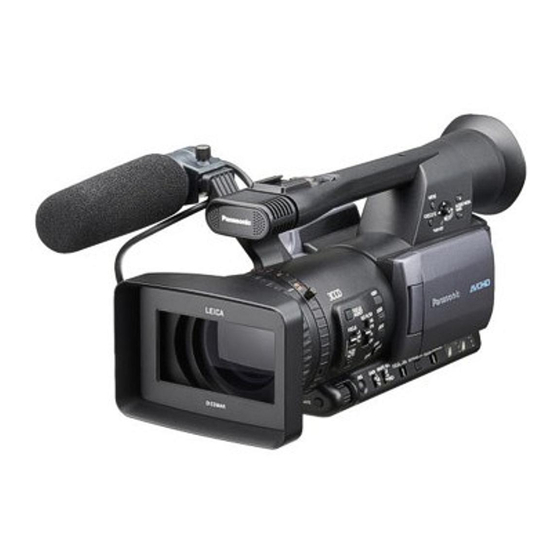Panasonic AG-HMC150 Manual do utilizador - Página 32
Procurar online ou descarregar pdf Manual do utilizador para Câmara de vídeo Panasonic AG-HMC150. Panasonic AG-HMC150 35 páginas. Avchd camcorder
Também para Panasonic AG-HMC150: Brochura e especificações (8 páginas), Menu de informações (20 páginas), Brochura e especificações (12 páginas), Brochura (16 páginas), Manual do produto (22 páginas), Instruções básicas (20 páginas)

24Mbps AVCHD, a higher-quality alternative to the
tape-based HDV format.
Oblique angle. See Dutch angle.
Off-screen space. Space beyond the camera's eld
of view which nevertheless the audience is aware of.
On location. Also called shooting on location. See
location shooting.
Optical Image Stabilization (OIS). A technique for
eliminating some of the shake from hand-held
shooting by compensating for the angular pan and
tilt movement of the camera. In most
implementations, it works by using a special lens
element that moves orthogonally to the optical axis of
the lens using electromagnets. Camera vibration is
detected by piezoelectric gyroscopic sensors, one
detects horizontal movement and the other to detects
vertical movement. Various vendors use a trade name
for OIS, for example, Sony calls it Super Steady
Shot.See also Electronic Image Stabilization.
Out-take. Any footage deleted from a lm during
editing; more speci cally, a shot or scene that is
removed from a lm before the nal cut.
Overcrank. To run lm stock through the camera
faster than the standard speed of 24 fps, producing
slow motion on the screen when the lm is projected
at standard speed. Also used to describe the
analogous effect in a video camera. See Undercrank.
Overhead shot. A shot photographed from directly
overhead, a.k.a. bird's eye view.
P2. A solid-state memory card used by Panasonic for
storage of video on some of their tapeless cameras.
PAL. Phase Alternating Line. e standard de nition
television and video standard in most of Europe.
Consists of 625 horizontal lines at a eld rate of 50
elds per second. (Two elds equals one complete
Frame). Only 576 of these lines are used for picture.
e rest are used for sync or extra information such as
VITC and Closed Captioning.
Pan. Short for "panorama." A shot where the camera
pivots horizontally, turning from left to right or from
right to left. Also called panning shot.
Petabyte. 1,000 Terabytes, or 1 million Gigabytes.
Today Terabyte drives are common, someday...
Phantom power. A technique for providing power
to condenser microphones through the same wire the
audio signal travels through. Most professional
condenser microphones require +48V phantom
power, which is a feature of many prosumer video
cameras..
Introduction to the Panasonic AG-HMC150 AVCHD camcorder (rough draft)
Pixel. Picture Element. e basic unit from which a
digital image is made. Essentially a dot with a given
color and brightness value. High De nition video
images are 1920 x 1080 pixels.
Plug-in Power. A consumer version of Phantom
power. Most Sony camcorders with a microphone
input and some audio recorders like the M-Audio
Microtrack and Roland R-09 HR provide plug-in
power in order to power a number of consumer and
pro-sumer condenser microphones. Unlike
professional Phantom Power, compatibility among
cameras, recorders, and microphones is not universal.
See Phantom Power.
Point-of-view shot (POV). A shot taken from the
vantage point of a character in a lm. Also called a
rst-person shot or subjective camera.
Pull focus. To change the focus of a lens during a
shot in order to follow a speci c object or person. See
rack focus.
Progressive scan video. An image scanning system
where each line is displayed progressively (1, 2, 3, 4,
5 ...) in contrast to interlaced scanning, consisting of
two elds: the rst eld (lines 1, 3, 5, 7 ... ) and then
a second eld (lines 2, 4, 6, 8, ...). Computer
monitors use progressive scan. e HDTV standard
includes several progressive scan options. Video has
historically been 60i (60 interlaced elds per second,
30 frames per second). e Panasonic DVX100 was
the rst prosumer camera to provide 24p and 30p
progressive scan. Today, many video cameras offer a
progressive scan option. Progressive scan offers an
image that is well suited for web video and for display
on computer monitors and at-screen displays. e
Panasonic can be used to shoot true 24p progressive
using 24pA (24p advanced) mode in which the
progressive frames are recorded onto interlaced video
using a 2:3:3:2 cadence which is then unravelled back
http://kino-eye.com/dvb/
32 / 35
